Employment Relations: Perspectives and Theories
VerifiedAdded on 2023/06/08
|9
|1959
|331
AI Summary
This essay critically evaluates employment relations perspectives for explaining their advantages and disadvantages while recognizing their corresponding criteria in employee relations. The essay constitutes the theory of effective industrial relations from the perspective of the employer, employer and government.
Contribute Materials
Your contribution can guide someone’s learning journey. Share your
documents today.
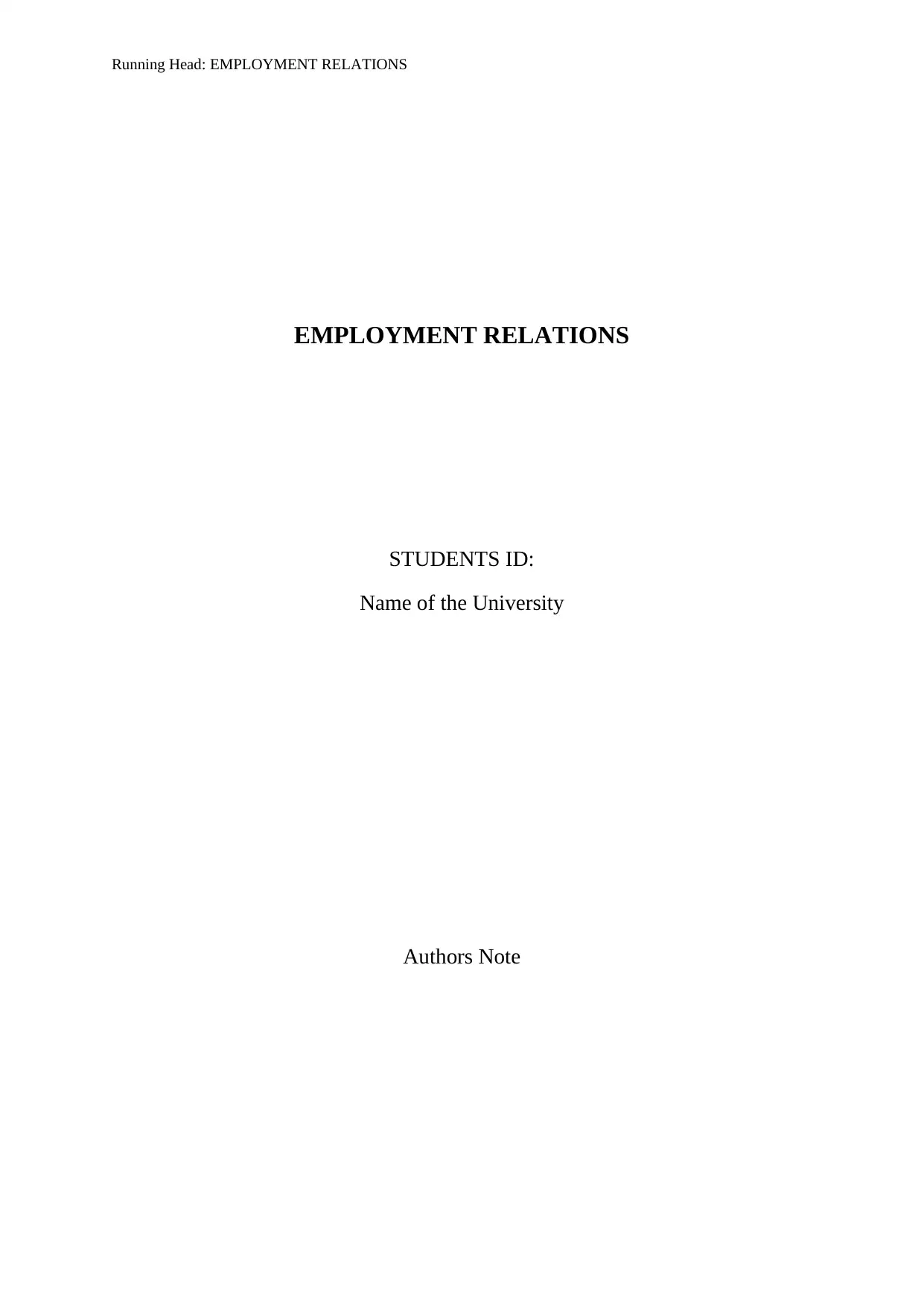
Running Head: EMPLOYMENT RELATIONS
EMPLOYMENT RELATIONS
STUDENTS ID:
Name of the University
Authors Note
EMPLOYMENT RELATIONS
STUDENTS ID:
Name of the University
Authors Note
Secure Best Marks with AI Grader
Need help grading? Try our AI Grader for instant feedback on your assignments.
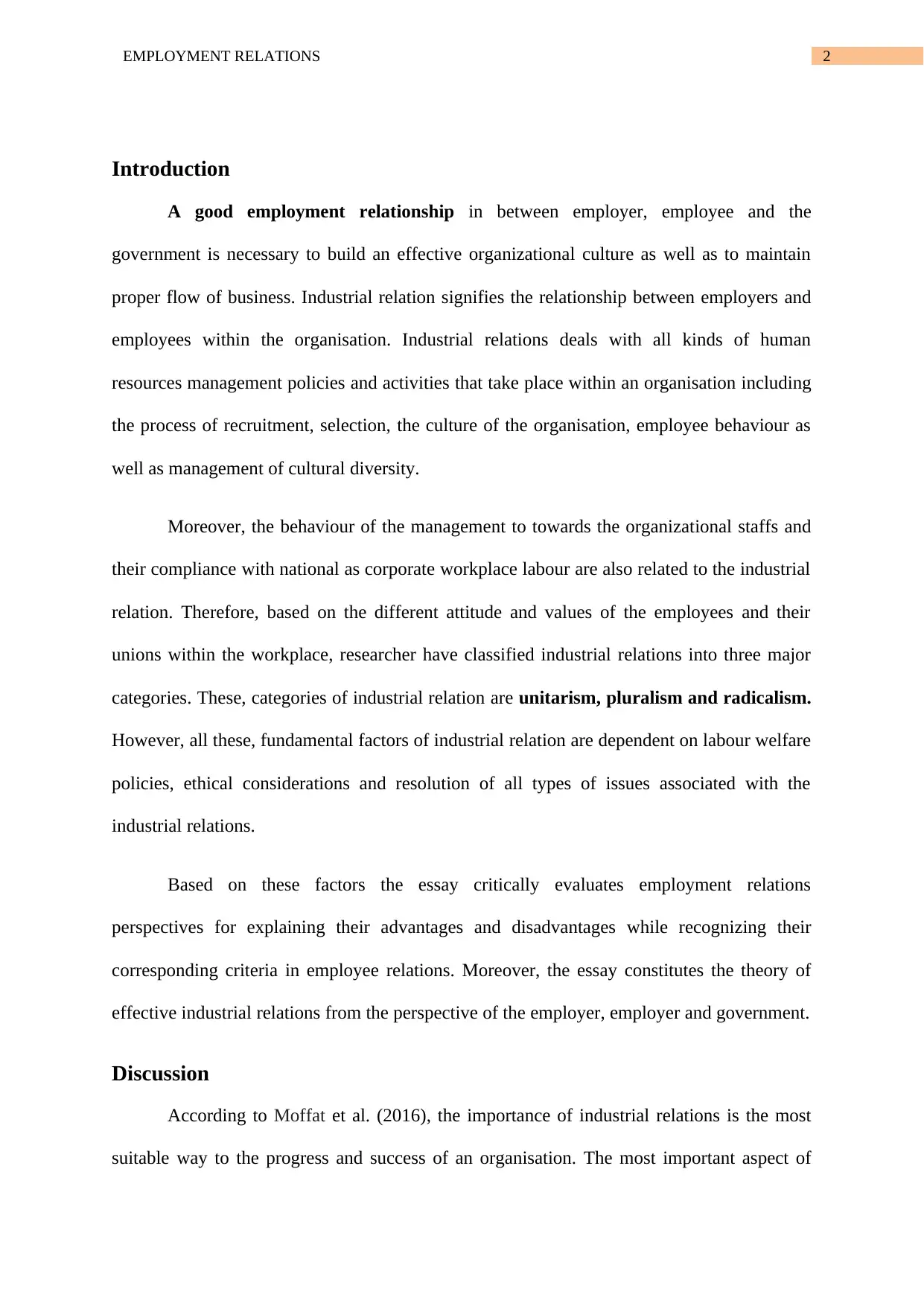
2EMPLOYMENT RELATIONS
Introduction
A good employment relationship in between employer, employee and the
government is necessary to build an effective organizational culture as well as to maintain
proper flow of business. Industrial relation signifies the relationship between employers and
employees within the organisation. Industrial relations deals with all kinds of human
resources management policies and activities that take place within an organisation including
the process of recruitment, selection, the culture of the organisation, employee behaviour as
well as management of cultural diversity.
Moreover, the behaviour of the management to towards the organizational staffs and
their compliance with national as corporate workplace labour are also related to the industrial
relation. Therefore, based on the different attitude and values of the employees and their
unions within the workplace, researcher have classified industrial relations into three major
categories. These, categories of industrial relation are unitarism, pluralism and radicalism.
However, all these, fundamental factors of industrial relation are dependent on labour welfare
policies, ethical considerations and resolution of all types of issues associated with the
industrial relations.
Based on these factors the essay critically evaluates employment relations
perspectives for explaining their advantages and disadvantages while recognizing their
corresponding criteria in employee relations. Moreover, the essay constitutes the theory of
effective industrial relations from the perspective of the employer, employer and government.
Discussion
According to Moffat et al. (2016), the importance of industrial relations is the most
suitable way to the progress and success of an organisation. The most important aspect of
Introduction
A good employment relationship in between employer, employee and the
government is necessary to build an effective organizational culture as well as to maintain
proper flow of business. Industrial relation signifies the relationship between employers and
employees within the organisation. Industrial relations deals with all kinds of human
resources management policies and activities that take place within an organisation including
the process of recruitment, selection, the culture of the organisation, employee behaviour as
well as management of cultural diversity.
Moreover, the behaviour of the management to towards the organizational staffs and
their compliance with national as corporate workplace labour are also related to the industrial
relation. Therefore, based on the different attitude and values of the employees and their
unions within the workplace, researcher have classified industrial relations into three major
categories. These, categories of industrial relation are unitarism, pluralism and radicalism.
However, all these, fundamental factors of industrial relation are dependent on labour welfare
policies, ethical considerations and resolution of all types of issues associated with the
industrial relations.
Based on these factors the essay critically evaluates employment relations
perspectives for explaining their advantages and disadvantages while recognizing their
corresponding criteria in employee relations. Moreover, the essay constitutes the theory of
effective industrial relations from the perspective of the employer, employer and government.
Discussion
According to Moffat et al. (2016), the importance of industrial relations is the most
suitable way to the progress and success of an organisation. The most important aspect of

3EMPLOYMENT RELATIONS
"good employment relationship is to ensure the continuity of production. These specifically
signify the continuous flow of employment for all the managers and the workers. On the
contrary, Parsons et al. (2014) state that disputes and conflicts in between employee and
employers are reflections of failure of basic human needs and the motivation to secure
sufficient satisfaction that can be completely solved by employee relation.
However, Ridley-Duff and Bull (2015) state that strikes, lockouts and unfair methods
to deal with the employees are few grievances laid down by the industrial conflicts and these
do not appear within an atmosphere of the industrial calm. At the end of everything, "good"
employee relations is dependent on the theory that is more persuasive such as unitarism,
radicalism and pluralism.
Unitarism
Unitarism, is the integrated and compatible system where the system of management,
employees and all the other members of the organization work under the vision of shared
objectives, purpose and values (Burrell and Morgan 2017). This authority of the system has a
structure of loyalty that is usually considered as the paternalistic approach where trade unions
are seen to be unnecessary and conflict is perceived as disruptive. In this theory of industrial
relation, the rights of the management in managing are perceived as legitimate and logical.
Weckowska (2015) stated that any opposition against the management is seen to be illogical.
Radicalism
On the contrary, Bolton et al. (2014) state that radicalism signifies the capitalistic
source of power where the authority and system of control expand beyond the corporate
limits and goes into the labour market. This theory allows fundamental rights such as the
"good employment relationship is to ensure the continuity of production. These specifically
signify the continuous flow of employment for all the managers and the workers. On the
contrary, Parsons et al. (2014) state that disputes and conflicts in between employee and
employers are reflections of failure of basic human needs and the motivation to secure
sufficient satisfaction that can be completely solved by employee relation.
However, Ridley-Duff and Bull (2015) state that strikes, lockouts and unfair methods
to deal with the employees are few grievances laid down by the industrial conflicts and these
do not appear within an atmosphere of the industrial calm. At the end of everything, "good"
employee relations is dependent on the theory that is more persuasive such as unitarism,
radicalism and pluralism.
Unitarism
Unitarism, is the integrated and compatible system where the system of management,
employees and all the other members of the organization work under the vision of shared
objectives, purpose and values (Burrell and Morgan 2017). This authority of the system has a
structure of loyalty that is usually considered as the paternalistic approach where trade unions
are seen to be unnecessary and conflict is perceived as disruptive. In this theory of industrial
relation, the rights of the management in managing are perceived as legitimate and logical.
Weckowska (2015) stated that any opposition against the management is seen to be illogical.
Radicalism
On the contrary, Bolton et al. (2014) state that radicalism signifies the capitalistic
source of power where the authority and system of control expand beyond the corporate
limits and goes into the labour market. This theory allows fundamental rights such as the
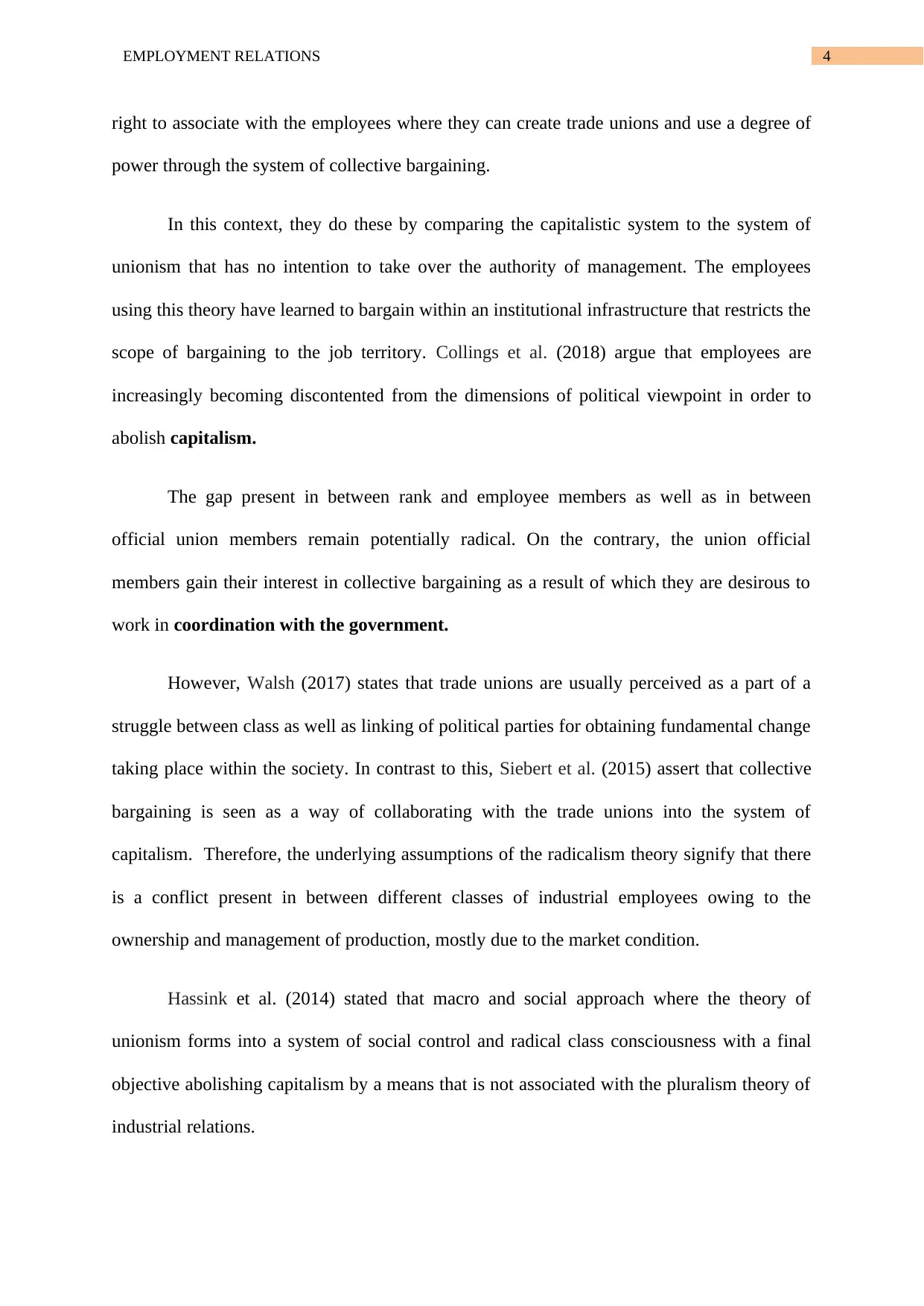
4EMPLOYMENT RELATIONS
right to associate with the employees where they can create trade unions and use a degree of
power through the system of collective bargaining.
In this context, they do these by comparing the capitalistic system to the system of
unionism that has no intention to take over the authority of management. The employees
using this theory have learned to bargain within an institutional infrastructure that restricts the
scope of bargaining to the job territory. Collings et al. (2018) argue that employees are
increasingly becoming discontented from the dimensions of political viewpoint in order to
abolish capitalism.
The gap present in between rank and employee members as well as in between
official union members remain potentially radical. On the contrary, the union official
members gain their interest in collective bargaining as a result of which they are desirous to
work in coordination with the government.
However, Walsh (2017) states that trade unions are usually perceived as a part of a
struggle between class as well as linking of political parties for obtaining fundamental change
taking place within the society. In contrast to this, Siebert et al. (2015) assert that collective
bargaining is seen as a way of collaborating with the trade unions into the system of
capitalism. Therefore, the underlying assumptions of the radicalism theory signify that there
is a conflict present in between different classes of industrial employees owing to the
ownership and management of production, mostly due to the market condition.
Hassink et al. (2014) stated that macro and social approach where the theory of
unionism forms into a system of social control and radical class consciousness with a final
objective abolishing capitalism by a means that is not associated with the pluralism theory of
industrial relations.
right to associate with the employees where they can create trade unions and use a degree of
power through the system of collective bargaining.
In this context, they do these by comparing the capitalistic system to the system of
unionism that has no intention to take over the authority of management. The employees
using this theory have learned to bargain within an institutional infrastructure that restricts the
scope of bargaining to the job territory. Collings et al. (2018) argue that employees are
increasingly becoming discontented from the dimensions of political viewpoint in order to
abolish capitalism.
The gap present in between rank and employee members as well as in between
official union members remain potentially radical. On the contrary, the union official
members gain their interest in collective bargaining as a result of which they are desirous to
work in coordination with the government.
However, Walsh (2017) states that trade unions are usually perceived as a part of a
struggle between class as well as linking of political parties for obtaining fundamental change
taking place within the society. In contrast to this, Siebert et al. (2015) assert that collective
bargaining is seen as a way of collaborating with the trade unions into the system of
capitalism. Therefore, the underlying assumptions of the radicalism theory signify that there
is a conflict present in between different classes of industrial employees owing to the
ownership and management of production, mostly due to the market condition.
Hassink et al. (2014) stated that macro and social approach where the theory of
unionism forms into a system of social control and radical class consciousness with a final
objective abolishing capitalism by a means that is not associated with the pluralism theory of
industrial relations.
Paraphrase This Document
Need a fresh take? Get an instant paraphrase of this document with our AI Paraphraser
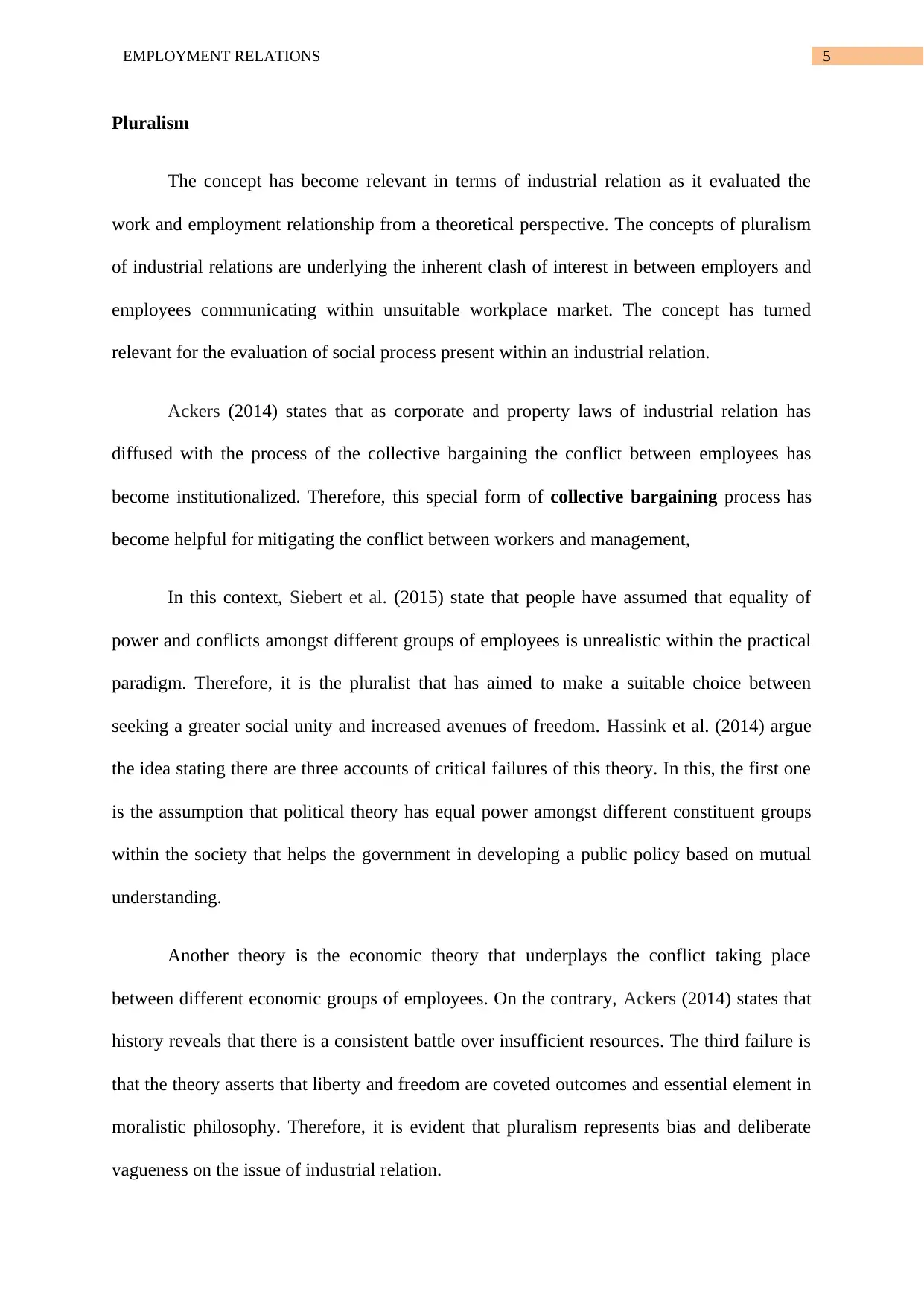
5EMPLOYMENT RELATIONS
Pluralism
The concept has become relevant in terms of industrial relation as it evaluated the
work and employment relationship from a theoretical perspective. The concepts of pluralism
of industrial relations are underlying the inherent clash of interest in between employers and
employees communicating within unsuitable workplace market. The concept has turned
relevant for the evaluation of social process present within an industrial relation.
Ackers (2014) states that as corporate and property laws of industrial relation has
diffused with the process of the collective bargaining the conflict between employees has
become institutionalized. Therefore, this special form of collective bargaining process has
become helpful for mitigating the conflict between workers and management,
In this context, Siebert et al. (2015) state that people have assumed that equality of
power and conflicts amongst different groups of employees is unrealistic within the practical
paradigm. Therefore, it is the pluralist that has aimed to make a suitable choice between
seeking a greater social unity and increased avenues of freedom. Hassink et al. (2014) argue
the idea stating there are three accounts of critical failures of this theory. In this, the first one
is the assumption that political theory has equal power amongst different constituent groups
within the society that helps the government in developing a public policy based on mutual
understanding.
Another theory is the economic theory that underplays the conflict taking place
between different economic groups of employees. On the contrary, Ackers (2014) states that
history reveals that there is a consistent battle over insufficient resources. The third failure is
that the theory asserts that liberty and freedom are coveted outcomes and essential element in
moralistic philosophy. Therefore, it is evident that pluralism represents bias and deliberate
vagueness on the issue of industrial relation.
Pluralism
The concept has become relevant in terms of industrial relation as it evaluated the
work and employment relationship from a theoretical perspective. The concepts of pluralism
of industrial relations are underlying the inherent clash of interest in between employers and
employees communicating within unsuitable workplace market. The concept has turned
relevant for the evaluation of social process present within an industrial relation.
Ackers (2014) states that as corporate and property laws of industrial relation has
diffused with the process of the collective bargaining the conflict between employees has
become institutionalized. Therefore, this special form of collective bargaining process has
become helpful for mitigating the conflict between workers and management,
In this context, Siebert et al. (2015) state that people have assumed that equality of
power and conflicts amongst different groups of employees is unrealistic within the practical
paradigm. Therefore, it is the pluralist that has aimed to make a suitable choice between
seeking a greater social unity and increased avenues of freedom. Hassink et al. (2014) argue
the idea stating there are three accounts of critical failures of this theory. In this, the first one
is the assumption that political theory has equal power amongst different constituent groups
within the society that helps the government in developing a public policy based on mutual
understanding.
Another theory is the economic theory that underplays the conflict taking place
between different economic groups of employees. On the contrary, Ackers (2014) states that
history reveals that there is a consistent battle over insufficient resources. The third failure is
that the theory asserts that liberty and freedom are coveted outcomes and essential element in
moralistic philosophy. Therefore, it is evident that pluralism represents bias and deliberate
vagueness on the issue of industrial relation.

6EMPLOYMENT RELATIONS
Conclusion
In reality, the paradigm of industrial relations is a specific process of accommodating
collective bargaining. The success of this process lies in the mitigation of conflict that is
taking place in between employees and management. Moreover, it depends on the
unconditional approval of certain wide social value where the industrial relation is managed
by a minor private property group. It has been seen from the study that both unitarism and
radicalism perspectives consist of least amount of conflict when applied to the industrial
relation.
Unitariasm perceives no conflict apart from the pathological condition whereas the
radical theory observed the industrial relationship as a source of society that has highly
accepted the basic system of industrialization. Therefore, both of this theory of approach does
not accept the presence of any intrinsic conflict engaged with the industry, employees and the
government. However, it has been that pluralism and radicalism theory have many unities in
between them. Both of these theories deduce their conceptual and philosophical value from
the system of capitalistic production and liberal political ideology. In this context, both of
these theory believes that liberty is needed to be endorsed even it comes at a price of social
inequality.
Therefore, pluralist industrial relationship perspective does not identify that
employment relationship is complicated in nature and it is necessary to understand the value
of employment relations in terms of creating policies, they rather argue that employee
relations are needed to be framed as a complex system of collective bargaining between
human agent and competing interest. Therefore, in the end, it can be said that a "good"
Conclusion
In reality, the paradigm of industrial relations is a specific process of accommodating
collective bargaining. The success of this process lies in the mitigation of conflict that is
taking place in between employees and management. Moreover, it depends on the
unconditional approval of certain wide social value where the industrial relation is managed
by a minor private property group. It has been seen from the study that both unitarism and
radicalism perspectives consist of least amount of conflict when applied to the industrial
relation.
Unitariasm perceives no conflict apart from the pathological condition whereas the
radical theory observed the industrial relationship as a source of society that has highly
accepted the basic system of industrialization. Therefore, both of this theory of approach does
not accept the presence of any intrinsic conflict engaged with the industry, employees and the
government. However, it has been that pluralism and radicalism theory have many unities in
between them. Both of these theories deduce their conceptual and philosophical value from
the system of capitalistic production and liberal political ideology. In this context, both of
these theory believes that liberty is needed to be endorsed even it comes at a price of social
inequality.
Therefore, pluralist industrial relationship perspective does not identify that
employment relationship is complicated in nature and it is necessary to understand the value
of employment relations in terms of creating policies, they rather argue that employee
relations are needed to be framed as a complex system of collective bargaining between
human agent and competing interest. Therefore, in the end, it can be said that a "good"
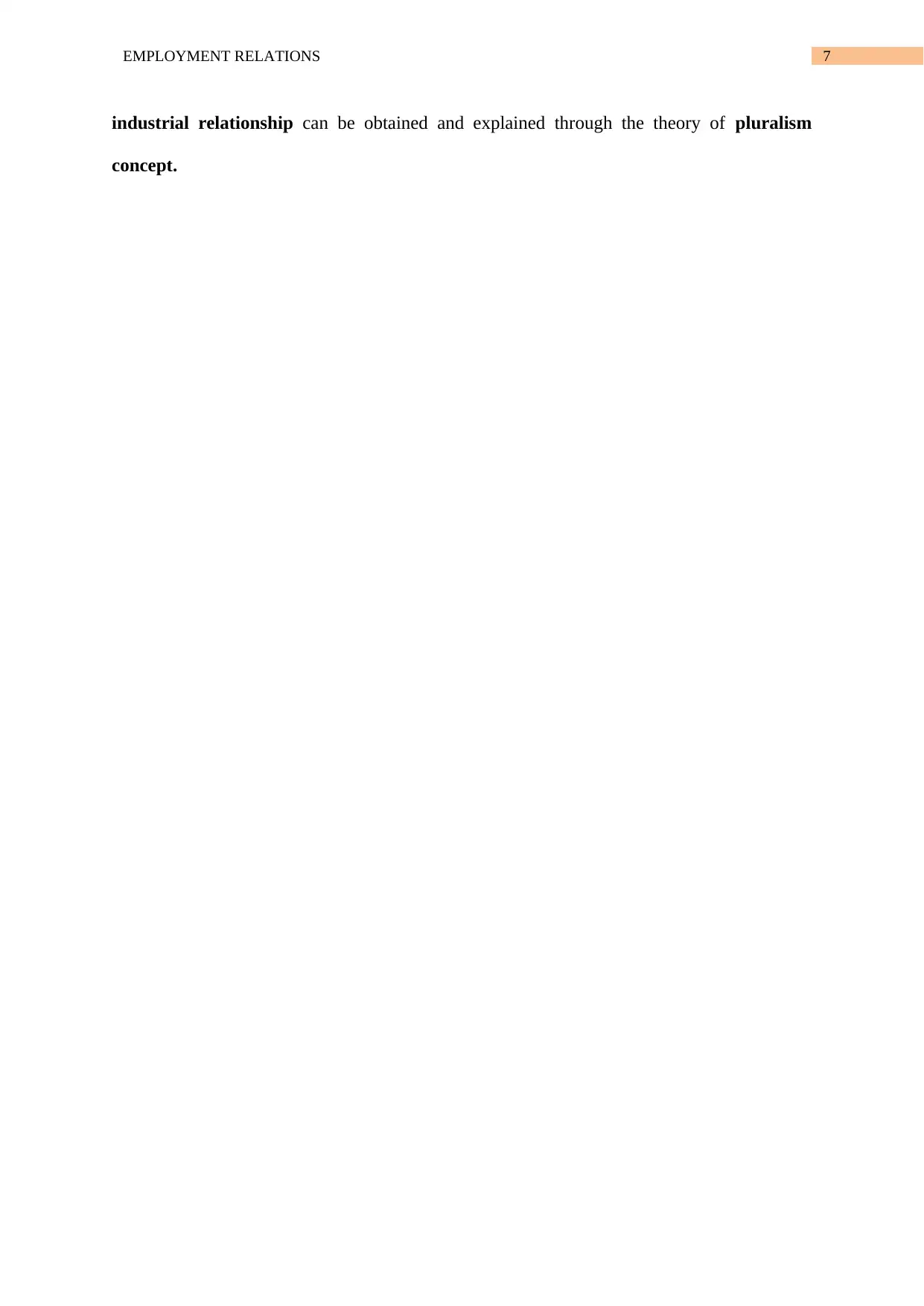
7EMPLOYMENT RELATIONS
industrial relationship can be obtained and explained through the theory of pluralism
concept.
industrial relationship can be obtained and explained through the theory of pluralism
concept.
Secure Best Marks with AI Grader
Need help grading? Try our AI Grader for instant feedback on your assignments.
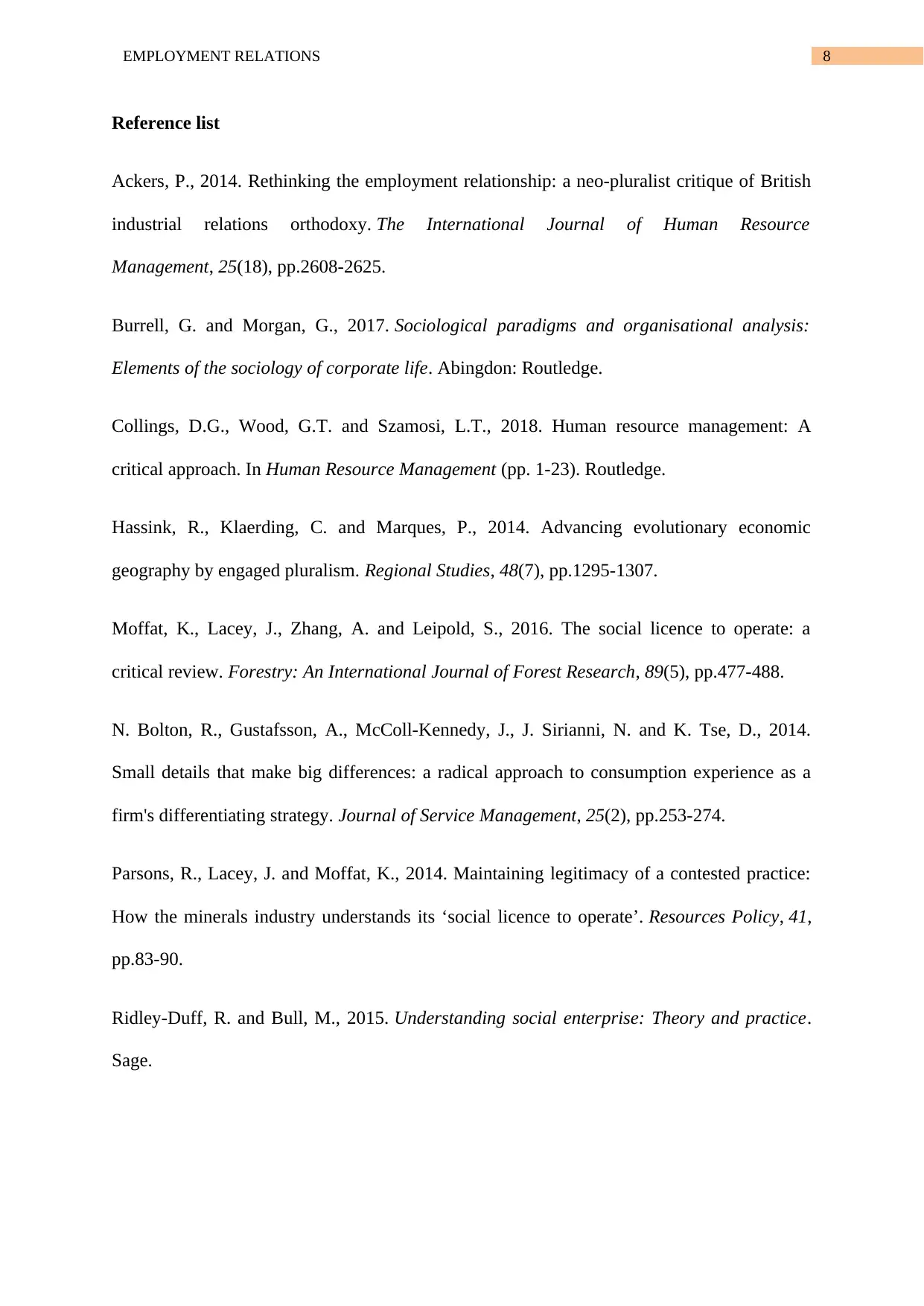
8EMPLOYMENT RELATIONS
Reference list
Ackers, P., 2014. Rethinking the employment relationship: a neo-pluralist critique of British
industrial relations orthodoxy. The International Journal of Human Resource
Management, 25(18), pp.2608-2625.
Burrell, G. and Morgan, G., 2017. Sociological paradigms and organisational analysis:
Elements of the sociology of corporate life. Abingdon: Routledge.
Collings, D.G., Wood, G.T. and Szamosi, L.T., 2018. Human resource management: A
critical approach. In Human Resource Management (pp. 1-23). Routledge.
Hassink, R., Klaerding, C. and Marques, P., 2014. Advancing evolutionary economic
geography by engaged pluralism. Regional Studies, 48(7), pp.1295-1307.
Moffat, K., Lacey, J., Zhang, A. and Leipold, S., 2016. The social licence to operate: a
critical review. Forestry: An International Journal of Forest Research, 89(5), pp.477-488.
N. Bolton, R., Gustafsson, A., McColl-Kennedy, J., J. Sirianni, N. and K. Tse, D., 2014.
Small details that make big differences: a radical approach to consumption experience as a
firm's differentiating strategy. Journal of Service Management, 25(2), pp.253-274.
Parsons, R., Lacey, J. and Moffat, K., 2014. Maintaining legitimacy of a contested practice:
How the minerals industry understands its ‘social licence to operate’. Resources Policy, 41,
pp.83-90.
Ridley-Duff, R. and Bull, M., 2015. Understanding social enterprise: Theory and practice.
Sage.
Reference list
Ackers, P., 2014. Rethinking the employment relationship: a neo-pluralist critique of British
industrial relations orthodoxy. The International Journal of Human Resource
Management, 25(18), pp.2608-2625.
Burrell, G. and Morgan, G., 2017. Sociological paradigms and organisational analysis:
Elements of the sociology of corporate life. Abingdon: Routledge.
Collings, D.G., Wood, G.T. and Szamosi, L.T., 2018. Human resource management: A
critical approach. In Human Resource Management (pp. 1-23). Routledge.
Hassink, R., Klaerding, C. and Marques, P., 2014. Advancing evolutionary economic
geography by engaged pluralism. Regional Studies, 48(7), pp.1295-1307.
Moffat, K., Lacey, J., Zhang, A. and Leipold, S., 2016. The social licence to operate: a
critical review. Forestry: An International Journal of Forest Research, 89(5), pp.477-488.
N. Bolton, R., Gustafsson, A., McColl-Kennedy, J., J. Sirianni, N. and K. Tse, D., 2014.
Small details that make big differences: a radical approach to consumption experience as a
firm's differentiating strategy. Journal of Service Management, 25(2), pp.253-274.
Parsons, R., Lacey, J. and Moffat, K., 2014. Maintaining legitimacy of a contested practice:
How the minerals industry understands its ‘social licence to operate’. Resources Policy, 41,
pp.83-90.
Ridley-Duff, R. and Bull, M., 2015. Understanding social enterprise: Theory and practice.
Sage.

9EMPLOYMENT RELATIONS
Siebert, S., Martin, G., Bozic, B. and Docherty, I., 2015. Looking ‘beyond the factory gates’:
Towards more pluralist and radical approaches to intraorganizational trust
research. Organization Studies, 36(8), pp.1033-1062.
Walsh, C.J., 2017. Are Multinational Enterprises’ Industrial Relations Strategies Shaped by
Host Countries’ Laws and Trade Unions?. Newcastle Business School Student Journal, 1(1),
pp.34-40.
Weckowska, D.M., 2015. Learning in university technology transfer offices: Transactions-
focused and relations-focused approaches to commercialization of academic
research. Technovation, 41, pp.62-74.
Siebert, S., Martin, G., Bozic, B. and Docherty, I., 2015. Looking ‘beyond the factory gates’:
Towards more pluralist and radical approaches to intraorganizational trust
research. Organization Studies, 36(8), pp.1033-1062.
Walsh, C.J., 2017. Are Multinational Enterprises’ Industrial Relations Strategies Shaped by
Host Countries’ Laws and Trade Unions?. Newcastle Business School Student Journal, 1(1),
pp.34-40.
Weckowska, D.M., 2015. Learning in university technology transfer offices: Transactions-
focused and relations-focused approaches to commercialization of academic
research. Technovation, 41, pp.62-74.
1 out of 9
![[object Object]](/_next/static/media/star-bottom.7253800d.svg)





